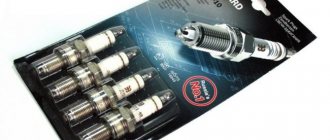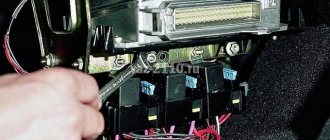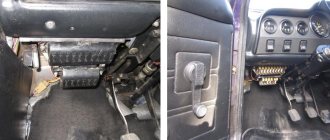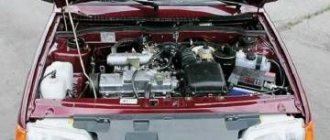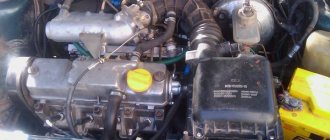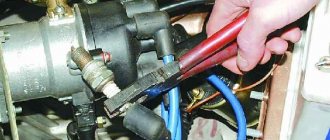It is characteristic that the spark plugs are filled with gasoline less often in the warm season, and more often at sub-zero temperatures. So let’s try to figure out in order: why the spark plugs in the injector are flooded, what to do to start the engine at the exact moment when they are flooded, and how to prevent them from being flooded with gasoline in the injector.
Reasons why the spark plugs in the injector flood
Calcination of spark plugs filled with gasoline
In principle, the reason why the injector spark plugs flood is simple. And the tones lie in the peculiarities of the “electronic brain” of your car.
At subzero temperatures, mixing the fuel-air mixture requires some effort: more oxygen in cold air requires more gasoline. Accordingly, the ECU gives a command to the injector nozzles to increase the fuel supply, which they do in good faith.
And the following happens in the engine, especially if your car no longer has a new battery. The injectors supply fuel to the combustion chamber, the starter tries to create the necessary compression in the cylinders, while at the same time trying to provide a spark to generate a flash. Do not forget about the quality of fuel, which does not have ideal parameters.
As a result, with ideal compression, the injector spark plugs can start even with a minimum impulse, but ideal compression is only found in a new car. Actually, this is why, as a rule, the injector spark plugs of a new car do not fill.
The spark is weak, compression in the cold does not correspond to the parameters, and the injectors continue to supply fuel to the combustion chamber. Which, in turn, floods the candles and they simply stop showing signs of fiery life.
This is the answer to the question - why are they filled in on the injector?
What to do if the spark plugs on the injector are filled with gasoline
There are two options for resolving the issue. As a rule, the “smart” operating book says: if the injector spark plugs are filled with gasoline, you need to unscrew them and dry them. With the spark plugs removed, crank the starter for 10-15 seconds. Put it back in and start the engine. These are actions according to the manufacturer.
A proven popular driving method. If your spark plugs are filled with gasoline, before unscrewing and drying them, try to start the engine in the following way: purge mode.
For the injector: the gas pedal is pressed all the way to the floor. Use the starter to crank the engine for 10-12 seconds, release the gas pedal. The engine should start. The fact is that in this way, by cutting off the fuel supply, you blow air through the spark plugs.
The engine did not start. Then try to dry them. Spark plugs for an injector are, in principle, no different from a carburetor engine. Therefore, we again use the “old-fashioned” method: we unscrew them, clean them from carbon deposits with a metal brush, or a toothbrush, and dry them either with a hairdryer, or on a gas stove or in the oven. We check the gap and screw the spark plugs for the injector into place. The engine should start.
For used cars, the recommendation of experts is to clean the spark plugs more often, or even better, replace them.
If the story of filling the spark plugs with gasoline repeats itself every morning, you need to carry out diagnostics: spark plug quality, injector cleanliness, spark output from the ignition coil, Hall sensor.
Conditions under which the spark plugs will not fill with gasoline
Naturally, these are ideal conditions, but you can control many of them so that you don’t have to meet the morning in a minibus while going about your business.
So, the main conditions are:
- a well-charged battery and a working starter,
- high-quality oil with appropriate parameters for the cold season,
- spark plugs and high voltage wires are of high quality and in good condition,
- the injector nozzles were promptly cleaned and adjusted. Preferably not with the help of various additives to the tank, but with the use of equipment for cleaning injectors,
- high quality gasoline
People's advice: if you want the engine to start normally in cold weather and the spark plugs not to be filled with gasoline, the engine needs to be “twisted” periodically, once a month. Distance 50-100 km. at a car speed of 100-120 km/h and on good fuel.
Or once every two days, while driving, give the engine a load of up to 4500-5000 rpm for 10 seconds so that self-cleaning of carbon deposits and deposits in the chamber occurs.
Fills candles with gasoline: reasons
The injector fills the spark plugs with gasoline due to the characteristics of the engine control unit. It is usually clear why the spark plugs on a VAZ 2110 or any other similar car flood during frosts. Going forward, we can say that the main reason why spark plugs are filled with gasoline is negligence and a discharged battery.
In order for the engine to start in cold weather, the engine control unit needs to supply more gasoline to the combustion chambers, because there is more oxygen in cold air, so more gasoline is needed. As a result, more fuel mixture is obtained, and the car usually drives more quickly if everything works well.
The engine's electronic control unit gives a signal to the injector nozzles to increase the fuel supply. They usually cope with this normally, if they work properly.
But if your battery is far from new, and in the cold the battery discharges faster, then a situation may occur in the engine when the injectors drive gasoline into the combustion chamber, and the starter creates the necessary compression in the cylinders, at this moment a high-quality discharge must appear for it to occur. flash. Also, a lot depends on the quality of the fuel, and high-quality fuel does not exist in nature in Russia.
As a result, it turns out that if the engine has ideal compression, and this only happens in a new car, then the injector spark plugs will be able to start the engine with the minimum permissible impulse. And if the car is not new and the battery has also become weak in the cold, then eventually the spark plugs will give a weak spark, and the injectors will supply fuel to the combustion chamber at full capacity, so the spark plugs will begin to flood, and they will finally stop giving a spark. This is why the injector floods the spark plugs because the battery is discharged. Therefore, if you have flooded the spark plugs in your VAZ 2114, then you know why this happened, and now we’ll find out what to do about it.
Video with example: how to solve the problem on the 1G-FE motor
There is probably no driver who has not encountered the problem of flooded spark plugs. In the evening the car runs fine, in the morning the engine does not want to start. This fact indicates the presence of certain problems in the car. After the engine has cooled down, the temperature, pressure and other parameters in the systems have changed, and the engine may well not start when it is “cold”.
Studying plaque on candles
They say that when candles are “flooded,” black soot forms. Let us clarify: it should not consist of inclusions. All metal, in turn, will be covered with an oily coating. Dry carbon looks different...
Oily layer and dry soot
The photo shows two cases. “Our version” is on the right.
We recommend: Getting the salon in order: 3 services
And soot can also be brown. And it always, in 100% of cases, is formed due to flooding with gasoline.
Dark brown soot
An oily coating, as in photo 1, is, nevertheless, the result of oil ingress. But an oiled candle does not work correctly - it will also be “flooded”.
With regular “flooding,” carbon deposits form, which we see in photo 1 on the right and in photo 2. The rest does not apply to our case.
What to do to prevent candles from flooding
We have looked at the reasons why the spark plugs on the injector are flooded. Now we need to figure out what to do in order to forget about the fact that gasoline floods the candles in cold weather. To do this, a number of preventative measures should be taken before frosts begin.
First of all, you need to monitor the battery charge level. In winter, it is better to equip your car with more powerful batteries. To prevent fuel from flooding the injector, the battery must be maximally charged. Therefore, if necessary, it must be recharged at night.
With the onset of cold weather, special attention should be paid to the quality of gasoline and oil. You shouldn’t skimp on this and it’s better to purchase only a high-quality product that suits the season.
Naturally, you need to monitor the serviceability of the spark plugs.
Clean them regularly and change them on time if they are faulty. The piston group also requires attention. It is responsible for creating compression, so when it wears out, the necessary pressure to ignite the air-gasoline mixture will not be achieved and fuel floods the spark plugs on the injector.
If it is frosty outside, then when starting the engine it is recommended to first load the battery. Then turn it off for a few minutes. Crank the starter and start the engine. If the launch is unsuccessful, then you need to wait about 10-15 minutes so as not to flood the injector, and repeat the launch. It is necessary to check the serviceability of the car before the onset of cold weather. If all components work properly, then there will be no problems starting the engine.
To summarize, the following conditions can be identified for optimal injector operation:
- the starter must be in working condition;
- the battery is fully charged;
- the lubricating fluid must correspond to the season;
- all high voltage wires and spark plugs must be in good condition;
- nozzles must be adjusted and kept clean;
- use only high-quality fuel.
To self-clean the engine, experienced car enthusiasts recommend going out on the highway every month and driving the car at a speed of 120 km/h.
Self-cleaning of the engine occurs due to strong pressure. You can clean the engine by running it in the morning at five thousand rpm for 10 minutes. The effect is similar to driving along a highway.
Monitor the condition of your car, then you will avoid unpleasant situations and save your nerves.
Possible solutions to the problem of flooded candles
The manufacturing plant has already foreseen the situation in which the spark plugs splash, and VAZ, for example, has the corresponding instructions in its passport. Basic recommendations for actions if fuel gets on the spark plug, which is called “cold”:
- Remove the candles.
- Crank the starter for 15 minutes without spark plugs.
- Wipe and dry the spark plugs well, then install them in their original place.
We recommend: CVT variator device
There is an alternative, so-called “folk” method. It must be applied even before the spark plugs are removed:
- Press the gas pedal all the way.
- Crank the starter for 10 -15 seconds.
- Return the pedal to its place.
Since at this moment there is no supply of fuel mixture, the spark plugs are purged and dried with air. If all else fails, remove the wet spark plugs and dry them thoroughly. Depending on the conditions, you can dry it over any heat source - fire, gas stove, hairdryer.
Calcination shortens the life of candles, so you should not heat them for a long time. After drying, the gap must be checked; if necessary, the gap is adjusted and the spark plug is installed in its place. If everything is done correctly, the engine should start.
Injection and carburetor spark plugs are practically the same, so the methods used can be used in both cases. If the spark plugs on the injector are flooded in the warm season, diagnostics of the fuel system and the sparking mechanism is necessary. If necessary, it is necessary to replace faulty components. At the same time, the condition of the injectors is checked, as well as the functionality of the Hall sensor.
The main reasons why spark plugs flood lie in non-compliance with the terms of preventive maintenance and technical regulations. Prevention can significantly increase the period of trouble-free operation of vehicle components. Therefore, even before the onset of frost, a number of preventive measures should be carried out:
- Constantly monitor the condition of the battery. In winter, it is generally better to install a battery with a higher capacity than was used in the warm season. With a powerful battery, a number of reasons for allowing fuel to flood the spark plugs disappear. It is best to recharge the battery at night, but in compliance with fire safety rules;
- During cold weather, increased attention must be paid to engine oil, and high-quality gasoline should also be filled, without contaminants. Consumable lubricants must be appropriate for the season;
- You must constantly monitor the condition of the spark plugs. It is necessary to regularly unscrew the spark plugs, remove carbon deposits from them, clean and adjust the gap. If technical characteristics deteriorate, it is best to replace the spark plugs.
Other reasons
In addition to the already mentioned main reason for flooding candles, there may be others:
- When starting, the crankshaft turns slowly (we are repairing the crankshaft).
- The malfunction lies in the valve stem seals, which allow oil to pass through (we change the valve stem seals).
- The injector is clogged, but continues to supply gasoline and fills the spark plugs with it (we clean the injector).
- Water appears in gasoline (this happens most often in winter, we choose the right brand of gasoline - “winter” or “summer”).
The latter case is also quite common, especially at sub-zero air temperatures. This is due to the fact that gasoline, which has low volatility, has a poor combination with cold air, so the fuel mixture becomes heterogeneous and begins to flood the spark plug elements.
If the candles are already filled, what to do next?
If there is a suspicion that at least one of the cylinders has a spark plug filled with gasoline, proceed as follows:
- Stop the starter, disconnect the electrical wiring, dismantle the spark plug;
- Cover the spark plug well to prevent dust from getting into it. Using a starter, rotate the shaft 10-15 revolutions;
- The candle is dried and replaced.
Here are recommendations developed by car manufacturers. Along with this, there are “people’s councils”:
- Before performing “step 1” discussed above, the spark plugs can be dried in the engine itself. When the starter is running, the gas pedal is pressed to the floor and air is sucked in through the ramp;
- To remove carbon deposits, you can use a brush designed for cleaning metal. A regular toothbrush will also work;
- If the compression in the cylinder is insufficient, changing or cleaning the spark plugs will be useless. Only a major overhaul will help here.
The recommendation that you need to press the gas to the maximum is only suitable for injection, but not for carburetor engines. However, the work of the latter was not considered here. Good luck.
When replacing or reinstalling spark plugs, it is advisable not to overtighten their fastenings. At the same time, an incompletely screwed spark plug will cause damage to all engine systems.
Features of starting a car in cold periods
In cold weather, before starting, you must first load the battery, then disconnect it for a while. After waiting a few minutes, you can try turning the starter to start the engine. If you fail to start the car on the first try, then in order not to fill the injector, you must wait a few more minutes. If all preventive measures were carried out in full before the frost, then there should be no problems with filling fuel.
We can list several conditions that are considered optimal for normal operation of the injector:
- presence of a working starter;
- maximum battery charge. The battery is powerful and in good condition;
- seasonal lubricant is used;
- spark plugs and high voltage electrical circuits must be in perfect condition;
- clean, adjusted nozzles are installed;
- The gas tank is filled with high-quality fuel.
There is an opinion among experienced drivers that driving a car along a highway at a speed of 120 km/h promotes self-cleaning of automobile systems, including the fuel system. You can also run the engine at 5000 rpm for about 10 minutes in the morning. The effect is similar to racing on a track.
It is believed that when high pressure is created in the systems, self-cleaning occurs. These measures can only be carried out if the car is in good condition and a significant increase in pressure in the systems will not harm it.
What steps do you need to take to get started?
The question arises, what to do if the car is not old, all systems are in order, but in the cold it refuses to start? When turning the spark plugs out, it turns out that they are wet. As already mentioned, in the cold season, the cause of this phenomenon may be weak compression, low-quality fuel or a weak battery.
Let's look again at the manufacturer's instructions. The book on car operation defines the following algorithm of actions:
- Turn out the spark plugs.
- Wipe them thoroughly and dry them.
- Run the starter for a few seconds.
- Put everything in place.
Often, car owners clean the injector using various fuel additives. This is not recommended at all, firstly, the quality of the fuel mixture is lost, which negatively affects the operation of the entire piston group, and secondly, the injector should be cleaned using special equipment.
Experienced drivers carry several sets of spare spark plugs with them . The quality of the spark produced depends on the technical characteristics of this ignition component. There is no point in saving on candles, their cost is not that high, and low-quality candles can cause a lot of problems.
How to prevent candles from flooding
As noted above, on new cars the question does not arise: what to do if the spark plugs are flooded, since this does not happen. But you can get rid of this on any car, you just need to comply with a number of important requirements. Firstly, you need to use special motor oil that does not thicken at low temperatures, this allows you to start the engine without much effort and stress on the battery and starter.
Secondly, high-quality fuel will not allow your spark plug to burn out. What to do if good gasoline is difficult to find? That's another question. At the very least, you shouldn’t look for gas stations with minimal prices, as you simply risk running into diluted fuel. The injection nozzles should always be adjusted and cleaned, this will have a positive effect on the starting time.
Why are the candles wet?
Sometimes a removed spark plug may be wet. This may be caused by gasoline, oil or coolant (antifreeze). Each of these liquids has its own determination methods.
We recommend: Inoperative window regulators: causes and solutions to the problem
Gasoline can be easily identified by its high volatility. By unscrewing the spark plug, the gasoline quickly dries out. Most often, filling with gasoline occurs when starting a cold engine. This can also happen due to incorrect ignition adjustment.
Oil on the spark plug electrodes may appear due to significant wear of the oil seals in the valves. Less commonly, the cause may be wear of the engine cylinder-piston group or breakage of the oil rings on the piston. Any of these faults requires immediate repair.
The amount of oil on the spark plugs can indicate how serious the problem is. When diagnosing, it is best to use a set of new spark plugs recommended by the car manufacturer, since droplets of oil are clearly visible on a clean insulator. The first stage is the appearance of small dark spots from burnt oil. This will not affect the performance of the spark plug in any way, but will indicate that there are still problems with the engine. The next stage of oil entering the combustion chamber will be the moistening of the lower threaded part of the spark plug. This condition of the spark plug will cause popping noises in the muffler at idle. They disappear as the engine speed increases.
Next is coating the end of the threaded part of the spark plug with oil. In this case, a spark may not appear. The result is frequent claps in the muffler.
The last stage is the complete wetting of the candle from below. In this situation, a spark does not form at all. Therefore, a cylinder with such a spark plug does not work. You can find out about this by regular claps in the muffler, which do not stop with increasing speed. The engine starts to stall.
If oil enters the combustion chamber with completely working fuel supply and ignition systems, then its combustion occurs on the electrodes of the spark plug. As a result, the oil does not have time to wet the candle. That's not to say it's good, but it's not too bad either. In this case, droplets of burned oil turn into ash. It accumulates on the electrodes, increasing their thickness. When the engine is running, the ash warms up well. This promotes further combustion of the incoming oil. It is easy to clean, but it is better to do this at the same time as replacing the valve seals. If you remove the ash from the candle, the oil may stop burning. Because of this, the spark may stop jumping, the spark plug will flood, and the cylinder will stop working.
Sometimes “traditional craftsmen” use the following methods to combat flooding of candles: install candles with a shorter skirt or with a higher heat rating, increase the spark voltage by putting on high-voltage tips, leaving a small gap. All these methods are short-lived, ineffective, and are dangerous for the condition of the car.
The reasons for the ingress of coolant may be the following: a poorly pressed cylinder head, a crack in it or in the liner body, a leaky carburetor heating system. As for the last reason, it is typical only for Japanese cars.
In practice, it is difficult to determine whether antifreeze enters the combustion chamber, since when the engine warms up, some holes may close as a result of metal expansion. Diagnostics must be carried out on a cold engine. To do this, you need to start the car for about 10 seconds. During this time, the candles will not have time to heat up and the cracks will not disappear. When the spark plug is removed, the coolant looks like dew drops.
When buying new spark plugs, you should be wary of counterfeits, as they can cause the entire engine to fail. They can be identified by a crooked or uneven inscription, poor-quality processing of the hexagon of the candle, or poorly executed packaging.
The spark plugs are filled with gasoline, what should I do?
There are several options to correct the situation: the simplest is to unscrew the spark plugs from the engine and dry them. After removing the spark plugs, you need to turn the key in the ignition switch so that the starter spins for about 15 seconds, after which you can put the dried spark plugs back in and turn on the engine. This is what the car manufacturer recommends and writes in the operating instructions.
You may also be interested in: Do-it-yourself car body repair before painting
But there is another proven method - if the spark plugs are filled with gasoline, then before unscrewing the spark plugs and starting to dry them, you should try to start the engine using the purge mode.
To turn on this mode, in a fuel-injected car you need to press the gas pedal to the floor and turn the key in the same way so that the starter spins for about 12 seconds, after which you need to take your foot off the gas pedal, and the starter should continue to spin. The engine should start at this moment, after releasing the gas pedal.
It turns out that when you turn off the fuel supply, the spark plugs are blown out with air. If after such manipulation the engine still does not start, then you need to dry the spark plugs. Injection spark plugs are no different from carburetor spark plugs, so you can safely do the same as they have been doing for centuries - they unscrewed the spark plugs, cleaned them of carbon deposits with a metal brush, and therefore dried them with a hairdryer or gas stove. After drying, you can check the gaps and screw the spark plugs back in. After this, the engine should definitely start.
To prevent this situation from occurring frequently, you need to periodically clean the spark plugs or change them on time. If you fill the spark plugs on an injection engine with gasoline every time when they are cold, this means that you need to do diagnostics - check whether the spark plugs, ignition coils, high-voltage wires, injectors and Hall sensor are normal. If all these components are normal, then the question of whether the injector can fill the spark plugs will disappear by itself.
Solutions
There are two ways to resolve this problem.
The essence of the first is as follows. To begin, unscrew and dry the candles. After this, turn the starter for about 8-12 seconds. Upon completion of the operation, the spark plugs are installed back and an attempt is made to start the engine.
The second method is to start the engine in “purge mode”. The procedure is as follows:
- pressing the gas pedal all the way
- turning the key in the ignition
- crank the starter for 8-10 seconds.
- returning the pedal to its original position.
The essence of the method is that when the gas pedal is pressed all the way, the gasoline supply is shut off, and the spark plugs are blown only with air.
If after performing the above steps the engine still does not start, you need to dry the spark plugs.
To dry candles, you usually use a toothbrush and a hair dryer. Sometimes you can find such a solution to the problem as piercing a candle on the burner.
If the spark plugs are filled daily, then you need to check the presence of a spark output, its quality, injectors, etc.
It happens that almost every day the spark plugs on the injector are filled. In such a situation, it is necessary to carry out a full check of the elements - for the presence of spark output, cleanliness of the injectors, quality of the spark, and so on.
We are looking for reasons why the spark plugs on the injector are flooded
Both lean and too rich mixtures cause the engine to stall. But the ECU cannot be wrong... The injectors, in turn, may be clogged - everything is clear here. And in cold weather, the valve may not close well due to ice formed.
Gasoline stain on the water
Conclusion: It is advisable to use fuel with zero water content. A carburetor filled with water may simply freeze, and each of the four (six, eight) injectors will flood the spark plugs at startup.
Main list
The main reasons why the engine floods the spark plugs include the following:
- In winter - the presence of water in gasoline;
- The evaporation coefficient must correspond to the air temperature (season). There is “summer” and “winter” gasoline. By the way, the indicated coefficient has nothing to do with the octane number;
- Clogged injectors are the reason for preparing a lean mixture;
- Slow cranking at start-up is also a common cause;
- Faulty valve stem seals contribute to the presence of oil in the combustible mixture.
When adding ferrocene additives, the second reason is aggravated. And they fight the fourth reason by moving to using the “right” oils. The material should not freeze in cold weather.
Oil 10W40 at -30 C
Recommended SAE ratios: 0W, 5W, but not 10W.
How they do it in practice
You can start a fuel-injected internal combustion engine in winter with both winter and summer fuel. It’s just that in the second case the mixture will have to be made leaner. The question is how to achieve this... For example, you can flash a “winter” program. Or do this:
- Before starting the engine, the temperature sensor is temporarily disabled. Instead, a sensor heated in the hands is put on the plug;
- We are trying to turn on the starter... The ECU “thinks” that the engine is warmed up and prepares a leaner mixture than it should.
Note that the DTOZh sensor will be attached to the thermostat.
Connector DTOZH ECU, VAZ-2114 car
We recommend: Removing scratches on a car body without painting
If the number of sensors exceeds 1, disconnect the one to which two wires go. It is always connected to the ECU.
Fuel with low volatility does not combine well with cold air - the mixture turns out to be heterogeneous. But if the concentration is lowered, the problem is solved.
Why are the candles flooded?
Let's first look at the reasons why the spark plugs on the injector are flooded. To do this, consider the operation of a car starter.
Thanks to the operation of its pistons and valves, a mixture of gasoline and air is supplied to the combustion chamber, which is ignited by a spark generated by the spark plugs. After ignition, the starter turns off. Thanks to ignition, the engine cylinders start working. To successfully start the engine, you need a working starter, a powerful battery and a favorable ambient temperature.
At low temperatures, gasoline does not mix well with air. It is known that frosty air contains more oxygen. An increase in oxygen content requires the supply of more gasoline. The vehicle's electronic control unit sends a signal to the fuel injectors, which increases the fuel supply. Thanks to the starter, compression is created in the cylinders and at the same time a spark is formed to ignite the fuel mixture. But since the compression does not meet the standards and the spark is weak, the incoming gasoline will flood the spark plugs, preventing the mixture from igniting. This is the reason why candles are poured in cold weather.
The formation of a spark is influenced by the following factors:
- Gasoline quality. It should not contain many impurities and dirt, as this will affect the operation of the injectors.
- Engine wear. If the engine pistons are worn out, they do not create the necessary pressure and fuel may flood the injector.
- Quality of candles.
- Quality of injector and carburetor.
- Battery power: You should monitor its charging.
If the compression is ideal, the engine will start even with minimal impulse and fuel fluid will never fill the injector. But only a new car can boast of such compression. If a car, for example, such as a VAZ, is more than three years old, gasoline fills the spark plugs on the injector more often.
Let's sum it up
Taking into account the above, it becomes clear that for normal starting and operation of the engine it is necessary to create certain conditions. It is also important to remember that increased requirements are put forward in winter. In an effort to achieve a stable start, novice car enthusiasts often ask which spark plugs do not fill. You can immediately answer that in the event of a malfunction, any spark plugs will flood, even new ones. This happens regardless of the brand, the condition of the candles themselves, design features, brand, etc.
Please note that to prevent gasoline from flooding the spark plugs, you must:
- monitor the battery charge, recharge the battery using a charger;
- the starter must be in good working order; jamming, slipping, etc. is not allowed;
- The engine must be filled with oil that corresponds to the current operating conditions (viscosity suitable for winter, as well as other parameters);
- The power supply system must be absolutely in good working order, the injector nozzles must be cleaned in a timely manner. For cleaning, it is advisable to resort to more effective methods of cleaning injectors with ultrasound or to wash the injector on a special washing stand, and not limit yourself to just preventive additions of various cleaners to the fuel tank;
- It is advisable to refuel only at proven gas stations that have certificates confirming the quality of the fuel;
- regularly check the condition of spark plugs and high-voltage wires;
In order to prevent carbon formation in a working engine, experts recommend periodically spinning the power unit to high speeds (about 4500-5000 rpm), after which you need to drive at least 30-50 km in this mode. This is especially true for cars that are constantly used in urban environments. Factors such as: prolonged operation at idle, short trips in low gears, low revs and driving at low speeds, underheating of the engine (the unit does not have time to fully reach operating temperature) lead to increased accumulation of carbon deposits and engine coking. Increasing the speed and load above the average level allows for partial cleaning of soot and deposits in the combustion chamber of the internal combustion engine in a natural way.
Why is this happening
The operation of injection engines, where the mixture is formed in the volume of the fuel rail, is always controlled by a special controller. The control unit in question is also called “ECU”:
The injection engine will not start without an ECU
The program installed in the unit’s memory constantly determines how many milliseconds each of the injectors should open. The longer the nozzle is open, the richer the mixture is formed. And in winter, at low temperatures, the controller strives to enrich the mixture to the maximum. And then the following happens:
- The concentration of gasoline in the mixture turns out to be maximum, but the temperature of the fuel and air remains lower than typical for the summer period;
- Compression in the cylinder, due to worn parts, may be insufficient;
- If there is carbon deposits on the spark plug contacts, sparking does not occur as the developers expected.
In total, these three factors lead to the following result: the fuel does not burn, but gets onto the spark plug contacts. As a result, sparking stops, and then, when you try to start the engine, gasoline is pumped into the cylinder. Then at a certain moment the fuel detonates.
When the spark plugs are filled with fuel, you can observe the same symptoms on any car. Starting does not occur during starter operation, but the driver will hear popping noises characteristic of such cases (the result of detonation).
What are the causes of flooding and how does it happen?
If we are talking about the situation with flooded spark plugs, then it does not matter what exactly we have - an injector or a carburetor. These types of engines are not equipped with any special protection against possible flooding. However, after this incident the engine may not start. In addition, there may be a smell of gasoline, as well as cranking of the starter. However, it is important to see residues of oil or gasoline on the spark plugs and to notice carbon deposits.
To analyze the situation with the candles, you will need to unscrew them. The bay is quite simple. The fuel supplied to operate the engine does not ignite. At the same time, the spark plugs begin to get wet, which does not allow the engine to start as we are used to doing normally.
Fuel supply and sparking process
When negative temperatures set in, the fuel mixture becomes insufficiently saturated with air; this occurs as a result of an increase in oxygen in the air during frost. Increased oxygen concentration requires increased fuel supply. If the electronic control is in order, then the corresponding command is sent to the injectors and the fuel supply is normalized in accordance with the temperature regime.
When starting, the starter creates compression in the cylinders while simultaneously producing a spark at the spark plug. As a result, the fuel mixture ignites and the engine performs a power stroke.
If the compression is weak and sparking is insufficient, the fuel mixture does not have time to ignite and simply gets on the spark plugs, then starting the car becomes problematic.
Factors influencing normal sparking:
- quality of the fuel mixture. The presence of dirt and large amounts of impurities negatively affects the functioning of the injectors. They simply become clogged with dirty fuel;
- engine condition. Wear of the pistons does not make it possible to create the necessary pressure in the combustion chamber, so fuel, not finding an outlet, begins to flood the injector;
- non-standard or low-quality candles;
- condition of the carburetor and injector;
- battery charge state. A dead battery cannot crank the starter.
There is a spark, the starter turns normally, but the spark plugs are flooded
Quite often you can encounter a situation where there is a spark, the spark plugs are flooded, and the starter spins the crankshaft well. In such a case, the spark plugs may require a separate check, since the presence of a spark on them does not mean that the same spark will always be created under pressure. In other words, if there was a spark on the unscrewed spark plug, then after installation on the engine it may disappear. The reason is increased pressure in the combustion chamber, which is created during the operation of the internal combustion engine. To find out, you need to carry out diagnostics on a special stand for checking spark plugs, which simulates the operation of these elements taking into account high pressure (similar to the operation of spark plugs in the combustion chamber).
Dealing with the consequences
Let's figure out what to do if the candles are flooded. If the motorist is sure that this has happened, then it is worth drying them using one of the selected methods. Most operating instructions for cars with fuel injection systems recommend immediately unscrewing them from the socket with a spark plug wrench.
At the next stage, dry the engine by cranking the starter without spark plugs for about 10 seconds. After drying, we return the spark generators to their sockets and try to start in normal mode.
It is allowed to start the engine with the spark plugs filled with the option of purging the cylinders. In many situations, this option will make it possible to start the power plant without additional removal of parts. Purge of cylinders in injection engines will be carried out by fully pressing the accelerator pedal during startup and cranking the starter for 10 seconds. Next, release the pedal and try to start normally.
It is important to understand that by pressing the gas pedal during purging, the driver opens the throttle valve as much as possible, which stimulates maximum air penetration into the cylinders and ensures drying of wet surfaces.
Even after purging, the engine may not start in some cases. Then you will have to dry the candles by first unscrewing them and cleaning them from carbon deposits in advance. You will need a medium hard brush. To remove moisture, a hair dryer or oven is suitable, after which check the gap between the electrodes.
After such operations, it is worth purchasing a new set of spark plugs, since the service life of the old ones is significantly reduced after calcination. Replacement is usually carried out after 15–25 thousand kilometers, regardless of the external condition. With frequent filling, it is necessary to get rid of the cause that causes it, and not the consequences.

